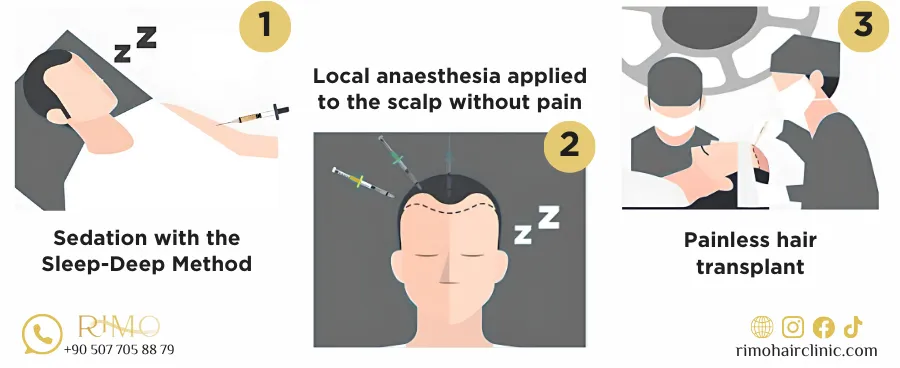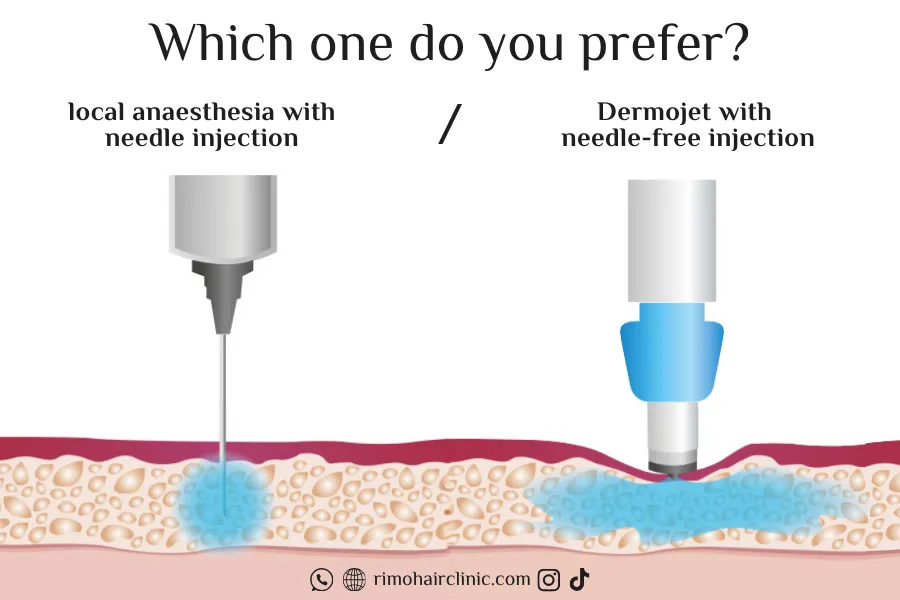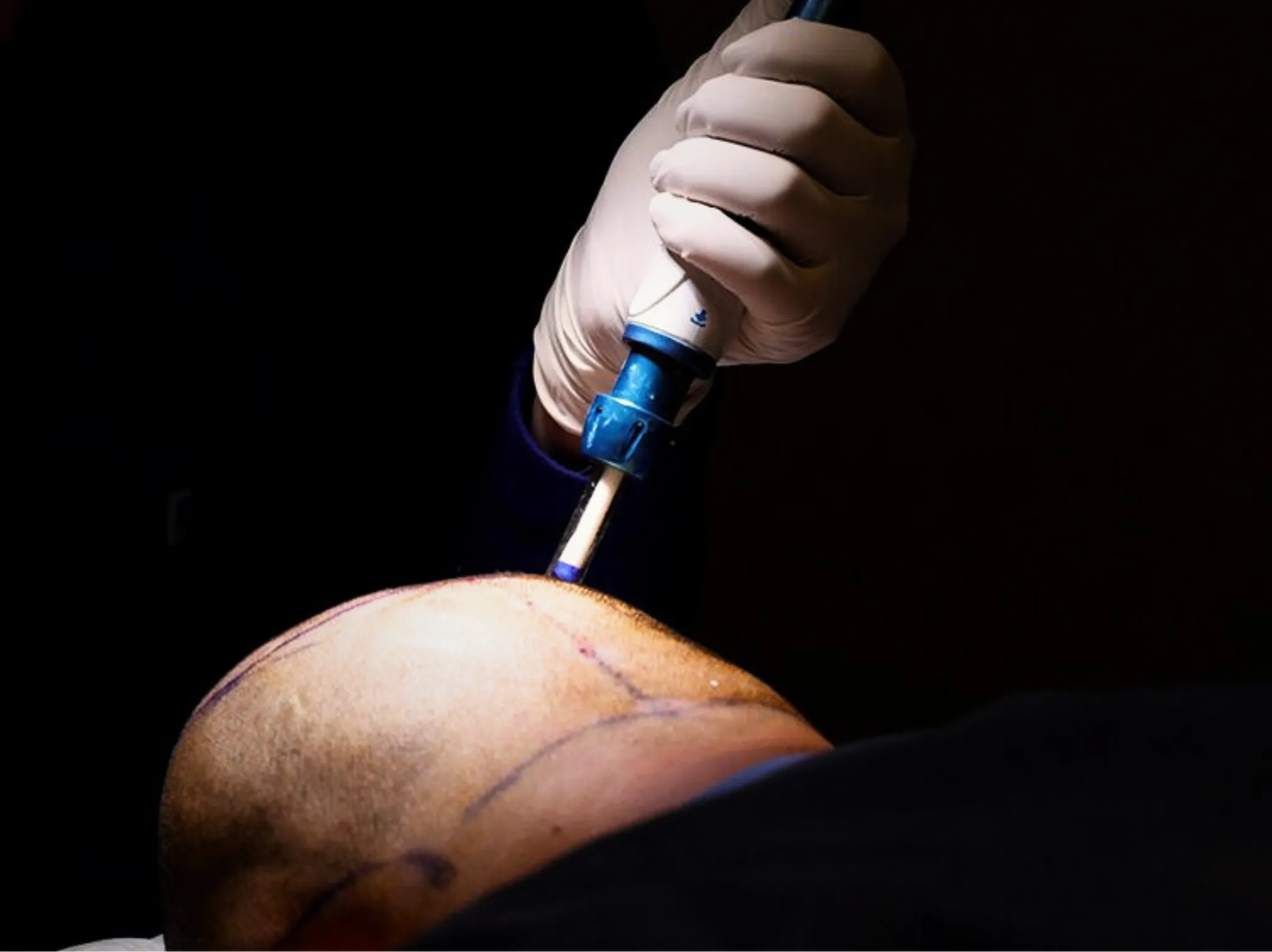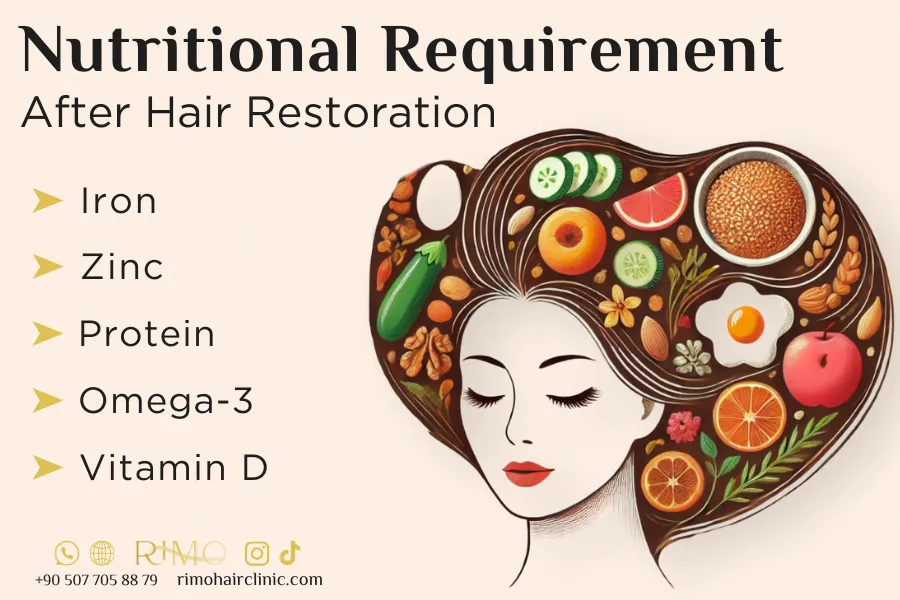Imagine yourself in a beautiful medical chair and within hours you are on the verge of getting the instincts of glorious hair and self-esteem. It means no stress, no pain at all, even that terrible needle feeling, as if you were actually drifting on the verge of sleep for a moment, while the specialists at the Rimo Hair Clinic in Istanbul were doing their work in silence to get you a new view of the world... How did this become possible?
Today with Needle-Free Anaesthesia Hair Transplant, with advancements in anesthesia techniques, hair restoration procedures have become more comfortable. Patients can now undergo surgery in a relaxed state, allowing surgeons to work with greater precision. This precision ensures optimal follicle placement, leading to improved post-surgery growth rates and more natural-looking results.
What are the anesthesia techniques in hair transplant? What options are available to those who are thinking of restoring their hair in a modern way? Join us on this expedition to uncover the secrets of cutting-edge anesthesia that is changing the lives of thousands around the world!
An overview of Hair transplant anesthesia pain in Istanbul
Turkey is considered one of the leading countries in the field of hair transplantation, as it annually receives thousands of patients from all over the world to perform Needle-free anaesthesia hair transplant in Istanbul, which depends on collecting follicles from an area with thick hair called the donor area and then transplanting these follicles into another area that suffers from hair loss, which we call the recipient area.
Rimo Hair Clinic in Istanbul shines as the key to a whole new experience by focusing on reducing pain as much as possible so that you can be confident that you will enjoy this procedure from A to Z using needle-free anesthesia techniques.

Needle-Free Anaesthesia for DHI and FUE Techniques
These anesthesia techniques aim to relieve pain, and they vary between the two types of Needle-Free Anaesthesia Hair Transplant and anesthesia using needle:
1- Hair Transplants And Local Anaesthetic (Pain Relief)
Its mechanism of action is based on injecting a specific drug mixture under the skin using fine needles similar to those used in insulin injections, in the donor area and the recipient area, where the skin is cleaned and sterilized before the injection begins, then the patient loses the feeling of pain within 15-20 minutes of application.
At Rimo Hair Clinic, we use this technique because it allows the patient to remain awake during the procedure. It is considered safe due to its local effect and doesn’t affect general body functions, and it doesn't require fasting from all types of food and drink before the operation.
On the other hand, the patient may feel temporary pain during the injection, and the surgeon may need additional anesthesia during the operation if the feeling of pain is restored to ensure the patient's comfort.
2- Needle-free Painless Local Anaesthesia with Dermojet
The Dermojet device is a high-pressure spray device that uses jet injection technology to introduce the anesthetic into the tissues to achieve the principle of Needle-Free Anaesthesia Hair Transplant. Instead of piercing the skin with a needle, the device relies on a powerful stream of pressurized fluids to push the anesthetic through the skin to the target layers.
How does needle-free hair transplant work ?
- The device is loaded with a specific amount of local anesthetic such as lidocaine.
- The anesthetist adjusts the pressure level according to the thickness of the skin and the target area to ensure proper penetration without causing tissue damage.
- The skin in the area where the injection will be done is disinfected to prevent infection.
- When the trigger is pressed, the Dermojet releases a very fine stream of anesthetic at high pressure through a very precise opening in the head of the device.
- This current penetrates the skin very quickly, crossing the epidermal barrier and reaching the deep layer of the skin (dermis). The anesthetic molecules spread through it, leading to numbing the area within a few seconds to minutes depending on the type of anesthetic.
In some cases, we combine needle-free painless local anaesthesia with dermojet for the following reasons:
Needle-free anaesthesia hair transplant is used in order to first lose the sensation of pain on the surface of the skin, making the subsequent needle injection painless and thus a more comfortable experience for the patient.
This technique is ideal for people who suffer from needle phobia (extreme fear of needles). However, the risk of infection is lower because it doesn’t penetrate the skin mechanically. However, its effect remains less lasting compared to traditional local anesthesia.

Sedation technique
Mechanism of action: The patient is anesthetized intravenously with sedative and analgesic medications like ketamine or sevoflurane. When this way takes place, the patient feels relaxed or even partly sleeps.
Once the anesthesiologist makes sure the patient is healthy, the vein is opened, and the sedatives are injected, then the local anesthetic is applied. Where the patient is relaxing.
The patient regains full consciousness approximately half an hour after the procedure ends.
Its advantages as an alternative technique to Dermojet in hair loss
- Reduces anxiety and fear, especially for people who are afraid of the shape of a needle.
- It makes the hair transplant experience more comfortable.
- The patient remains partially conscious, allowing him to respond to instructions when needed.
There is a need for a medical examination to be done prior to the prescription of sedation to make sure there are no health problems that can be the reason for the non-use of these kinds of drugs.
We are proud to let you know that Rimo Hair Clinic is bespangled with the presence of an entire medical team, an anesthetist being among them, who watches your condition from second to second to make sure that you are comfortable. Book your free consultation via WhatsApp
Is a Hair Transplant Done Under General Anaesthesia?
Since the hair transplantation procedure takes several hours and requires changing the patient’s position several times, general anesthesia is not preferred in needle-free anaesthesia hair transplant in Istanbul, and the patient must remain awake throughout the procedure while ensuring comfort through local anesthesia or sedation.
Warnings before Hair transplant anesthesia pain:
- Medications that affect the blood thinning, such as aspirin, should be avoided before the procedure.
- If there are chronic diseases such as diabetes or high blood pressure, a doctor must be consulted before anesthesia is performed.
- It is preferable to abstain from smoking and alcohol before and after the operation to ensure a faster recovery and reduce potential risks.
When Does Anesthesia Wear off After Hair transplant?
The duration of the hair transplant anesthesia wear off depends on the type of anesthesia used in hair transplantation and the area that was anesthetized. Here are the details of the technique and duration in the following table:
|
Type of anesthesia |
How long does anesthesia last after hair transplant? |
|
Local anesthesia in hair transplant |
It lasts 4 to 6 hours after the procedure |
|
Dermojet in hair loss |
Its effect is short and begins to wear off within 30-60 minutes |
|
Sedation Technique |
Its effect begins to wear off after 30 minutes to an hour, but the feeling of lethargy may last for several hours. |
Hair transplant anesthesia side effects
- Tightness in head & permanent numbness after hair transplant: Post operation, the patient feels a slight tingling or numbness sensation in the scalp, which is normal as a result of the effect of the anesthetic on the superficial nerves, and this feeling sometimes lasts for 24-48 hours.
- This can be alleviated by using mild analgesics prescribed by your doctor, such as paracetamol.
- Swelling of the face after transplantation, which is also a normal condition resulting from swelling after needle-free anaesthesia hair transplant. You can relieve it with cold compresses and take pain relievers if it is bothersome.
- We also advise you to rest and drink plenty of water and fluids.
What To Eat After Hair Transplant?
We have reached the favorite paragraph for most readers, which is the type of food and proper nutrition that is important to follow after hair transplantation because of its important role in accelerating recovery. Here is a list of foods that are prohibited after the transplantation process and it is recommended to avoid them for two weeks:
- Hot foods and strong spices that increase blood flow and cause irritation in the transplanted area.
- Fatty foods and heavy oils contain harmful fats that reduce blood flow and reduce healing.
- Processed foods and canned foods that contain preservatives negatively affect the safety of the transplanted follicles.
- Foods high in sugar and salt.
- Alcoholic drinks.
We advise you from Rimo Hair Clinic in Istanbul to focus on eating foods rich in proteins, vitamins, and minerals such as rice, lamb, broccoli, and green vegetables to enhance the healing process. For any inquiries, contact us via WhatsApp
Recent developments in needle-free anesthesia techniques
There are global trends in reducing pain and improving the patient experience using new needle-free anaesthesia for DHI and FUE techniques such as:
- Vibration-enhanced anesthesia techniques where vibrating devices are used during anesthetic injection to disperse pain signals.
- Anesthesia using advanced topical gel.
- Freezing anesthesia/cold anesthesia/cold anesthesia.
Cryoanesthesia in hair transplantation (Ice anesthesia)
When low temperatures are applied to the skin or surrounding tissue, blood vessels constrict, which reduces blood flow to the targeted area. This leads to a temporary inhibition of the function of sensory nerve endings, which reduces the transmission of pain signals to the brain. The duration of the effect of this technique is short and temporary.
- Ice anesthesia will numb the scalp before the collection and re-location of hair follicles, which will reduce the need for great amounts of local anesthetic as it is a form of Needle-Free Anaesthesia Hair Transplant.
- A crucial note to add is that excessive cold can cause tissue damage or so called a “frostbite.” Therefore, the temperature of the scalp and the duration of the anesthesia must be carefully controlled.
- Certain persons may be sometimes more sensitive to the cold so that it may quickly become cold and may even be irritated even more.
- It is recommended to avoid the use of cryotherapy in patients with: circulatory disorders or have increased sensitivity to cold conditions.
How do we reduce the pain and discomfort in hair transplant?
You can do this through Needle-Free Anaesthesia Hair Transplant, such as the Dermojet hair loss technique that we use at Rimo Hair Clinic, before local anesthesia to ensure that you get complete comfort and avoid anxiety.
How painful is a hair transplant?
The hair transplant procedure is considered to be a mild pain and goes away within 5 minutes, which is the period of anesthesia of the donor area and the area to be transplanted until the anesthetic takes effect in them.
The procedure depends on the skill of the doctor and the anesthesia technique in hair transplantation, such as Dermojet. The more you master these two factors and the more you follow your doctor’s instructions, the pain will be reduced as much as possible. Fortunately, you will find these two conditions available at Rimo Hair Clinic, with more than 14 years of experience. You can book your free consultation via WhatsApp for any inquiries.
Does needle-free anesthesia completely eliminate the use of needles?
This method does not completely eliminate the use of needles. By the way, this technology is also mentioned as pre-needle anesthesia which entails the numbing of the skin as a preliminary step by a needle-free. Then, the traditional needle injections are done in a painless way without making this process of needling the skin to be harmful to the patient.
When can I prostrate after a hair transplant?
You can prostrate after hair transplant anesthesia pain on the third day after the operation until we remove the bandage and the transplanted follicles stabilize, while avoiding pressure on the scalp area.
Read more: Hair transplant without shaving

